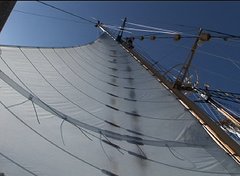 |
| Students and crew sport new haircuts in honor of their equator crossing |
 One of the big reasons why we are so surface-centric when it comes to marine policy is the simple fact that humans live on land, not in the ocean. Although we can swim, we have a natural fear of the open ocean, and the many perils and predators associated with it. Very few people have ever been 500 feet below the surface, much less 7km down in the deepest parts of the ocean. We understand the surface of the moon better than we understand the ocean, which makes up 70% of the planet we call home. Especially in the regions of the ocean where light does not penetrate, there are amazing creatures beyond our wildest imaginations, just waiting to be discovered.
One of the big reasons why we are so surface-centric when it comes to marine policy is the simple fact that humans live on land, not in the ocean. Although we can swim, we have a natural fear of the open ocean, and the many perils and predators associated with it. Very few people have ever been 500 feet below the surface, much less 7km down in the deepest parts of the ocean. We understand the surface of the moon better than we understand the ocean, which makes up 70% of the planet we call home. Especially in the regions of the ocean where light does not penetrate, there are amazing creatures beyond our wildest imaginations, just waiting to be discovered. A neat thing about being on the Robert C. Seamans is that we are getting to do so much of our own discovery, in places where not many people go, and not many people know very much about. On board, every student is working on a research project, and through mine I’m exploring the topography and ecosystems of the deep ocean. I am studying seamounts, or underwater mountains, many of which are comparable in size to the Rockies in my home state of Colorado. Since we didn’t bring a submarine with us and no one on board can hold their breath for long enough, we have been finding seamounts using a system called CHIRP, which sends little “chirps” of sound beneath the boat, and listens for the sound to bounce off the ocean floor and back to the boat. Since we know roughly how fast sound travels in water, and we can time how long it takes for the sound to return, we can figure out the depth of the ocean floor right beneath us. Finding these seamounts has been a really exciting journey for me, and I have felt like a detective throughout the entire process, getting a small glimpse into another world.
A neat thing about being on the Robert C. Seamans is that we are getting to do so much of our own discovery, in places where not many people go, and not many people know very much about. On board, every student is working on a research project, and through mine I’m exploring the topography and ecosystems of the deep ocean. I am studying seamounts, or underwater mountains, many of which are comparable in size to the Rockies in my home state of Colorado. Since we didn’t bring a submarine with us and no one on board can hold their breath for long enough, we have been finding seamounts using a system called CHIRP, which sends little “chirps” of sound beneath the boat, and listens for the sound to bounce off the ocean floor and back to the boat. Since we know roughly how fast sound travels in water, and we can time how long it takes for the sound to return, we can figure out the depth of the ocean floor right beneath us. Finding these seamounts has been a really exciting journey for me, and I have felt like a detective throughout the entire process, getting a small glimpse into another world.
As technology and culture shift more towards ocean exploration, we will keep discovering new things about the deep ocean – what it looks like, what’s there, and how we can protect it – and yet there will always be more to learn. We are so lucky to be on board the Seamans with so many opportunities to find out all we can about this amazing environment, and share it with the world.
- Emma Hutchinson


4 comments:
Was wondering when you all would be crossing the equator and shaving those heads!
Such a thoughtful and intelligent perspective, Emma. I cannot wait to discuss all of this with you in person soon! We love you :)
Thanks for the people photos! As much as we marvel at the unbelievable nature shots posted, Sam will tell you that a common family refrain when we look at his portfolio of pictures is: 'but where are the people?' So please keep the pix coming - we'd especially enjoy seeing the crew at the different work stations as we follow you on your fantastic journey!
I didn't know it was tradition to cut or shave one's hair crossing the equator! I'm guessing Andreas did not partake...
And I agree with Raquel. Thanks for posting people pics too!
Post a Comment